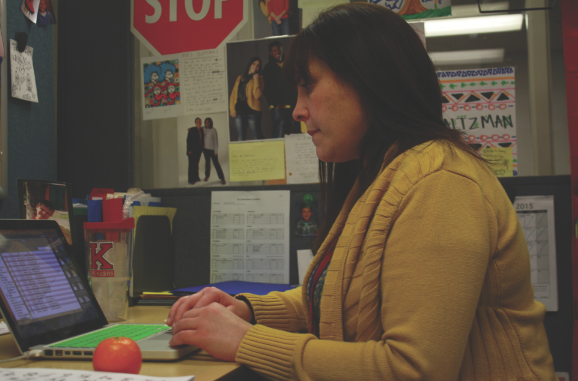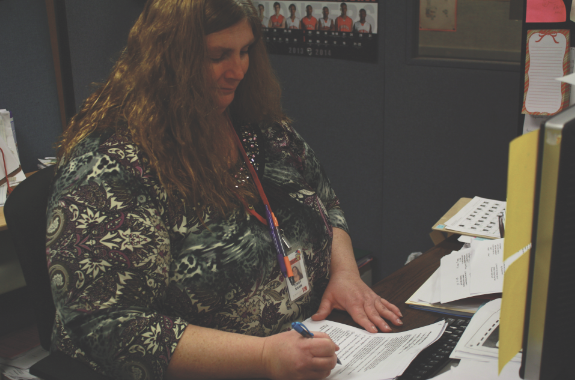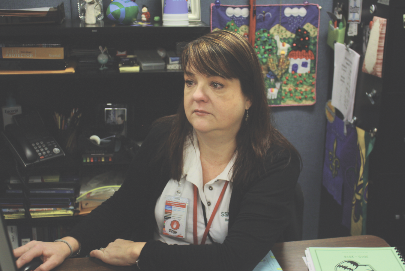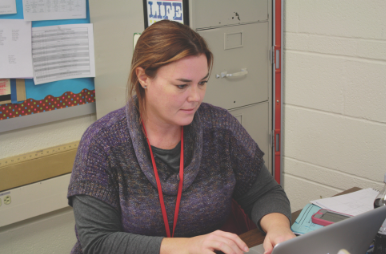Your donation will support the student journalists of Kirkwood High School. Your contribution will allow us to purchase equipment and cover our annual website hosting costs.
Meet the people of the Special School District
Cindy Shaw, Special School District teacher and Jessica Maltzman, Speech/Language Pathologist
October 6, 2015
Above the library is a peculiar place, and not many bother to explore it. It is a place not forgotten, or ignored, but instead simply unnoticed. In this “hub,” as it is often referred to by the ladies working in the loft – the Learning Resource Center (LRC) – one might find Cindy Shaw and Jessica Maltzman working alongside Special School District (SSD) employees.
Shaw and Maltzman co-teach classes with General Education teachers, working with a variety of special needs or learning disabled students in order to help them thoroughly learn the concepts of the class.
Currently, Shaw co-teaches World History with Tim Harig and Freshman Literature and Composition with Diana Hammond, along with independently teaching two modified classes of Freshman Literature and Composition. Shaw also has a learning strategies class which supports Freshman Literature and Composition. Maltzman co-teaches Geometry with Olivia Rea and Sophomore Literature and Composition with Katie Meyers. Maltzman also has a learning strategies class for Sophomore Literature and Composition along with a reading focus class. In addition to classes, Maltzman sees students who have multiple disabilities and are in need of her specific one-on-one expertise.
Through Individualized Education Plans (IEP), the teachers in SSD can comply with particular students, depending on their disability, and find what accommodations and modifications can be made. One approach they take is exploring varied ways of delivering the material to different students, whether it be placing them in the SSD or remaining in a General Education class. Shaw has found the close bonds she shares with her students have created humbling moments.
“The reason I love being a teacher is those ‘Aha’ moments,” Shaw said. “I [enjoy seeing] students get through a problem that has really frustrated them. That is why I keep coming back everyday.”
Shaw has two of her own children who have IEPs and as a parent, she said, it is difficult to see her own children work hard to learn a concept, constantly telling themselves they are not capable. SSD works toward bridging the learning gaps as a way to level the playing fields among students. The goal of co-teaching is to accommodate all students in the classroom, not solely the SSD students, as well as create seamless partnerships among teachers and students.
“When we are there in the classroom, we are there for everyone,” Maltzman said. “We all have areas that we need to problem solve.”
Maltzman administers standardized tests when students have difficulties in school as a way to identify where the student’s capabilities stand. Maltzman can determine where the student’s language skills are and what their weaknesses are, then, likewise to the IEPs, identifies if the student would be better supported in a General Education class or in a Special Education setting. After working with them, Maltzman can see the successes of the student and that to her is the most rewarding part of working with SSD students.
“My best memories have always been when my students have succeeded despite challenges,” Maltzman said. “It makes me excited for them. Then things start clicking and they see the value in things. Then it is all worth it.”
Special School District – Goldstein
Lee Goldstein, Special School District teacher : Community Based Vocational Instruction(CBVI)
As close to 1,900 students head through the doors of KHS, five individuals are leaving.
Every day, Lee Goldstein takes four seniors to SSM St. Clare Health Center in Fenton, where they will learn job skills for the future through a program called the Community Based Vocational Instructional Program (CBVI).
In 2005 Goldstein moved from New Orleans and started teaching at Tillman Elementary School. This year will be Goldstein’s third year at KHS and first year taking part in the Special School District’s (SSD) partnership with St. Clare. Prior to working with St. Clare, she took students to Manor Groves Residential Facilities to teach job skills, which was opened to both seniors and juniors.
Goldstein acts as a job coach, guiding her students past likely barriers that would restrict them from being employed. The program is a volunteer position, and the goals are for students to reach employment down the road and learn on-the-job training. The first month of the program is spent in the classroom learning the policies of the hospital, social skills, writing a resume, and orientations of the hospital.
Students selected by Goldstein must fill out a volunteer application from St. Clare’s, shadow all the possible positions at the hospital and are then placed in roles that are best fit for them.
Presently, the students are working with hospital employee mentors in hopes of gaining the skills and knowledge that will help them prepare for jobs with benefits in the future. Goldstein said she sees the advantages of the program and strives for her students to recognize it as well.
“[My best memory] is when the kids recognize the value of the program on their life.” Goldstein said.
The program at St. Clare’s offers many practical and realistic jobs for the students. Goldstein has a student in the Anesthesia Tech Department, where she cleans the rooms after surgery in the procedural center and stocks the operating room with supplies.
Another student from Lindbergh is in pharmacy tech, having already obtained her pharmacy tech licenses, she places pills into bottles, under the supervision of St. Clare employees, and recently has begun delivering the medicine to the rooms.
Goldstein performs a task analysis, which is a step-by-step form of what the kids do each day. She, along with the mentor, identify and determine whether the student is doing the tasks independently, more dependently, or if it is something that he/she has not been exposed to yet. Once or twice a week she gathers the students back into a classroom to relearn the skills and provide additional tips.
After working with Special Education students, Goldstein experiences the firsthand accomplishments of the students and their growth as people, students and adult workers. She appreciates the efforts of her students and the values the students need to grow beyond their impairments.
“It takes patience and compassion and pushing people to do the best they can do,” Goldstein said. “[I recognize] that people are not their disability but to provide them with the abilities to be a contributing member [in society] and to be successful in life.”
Special School District – Webb
Lisa Webb, Special School District teacher
Every school day she looks out into an expanse of warming faces. She sees student’s minds that can be molded, not their disabilities.
Lisa Webb teaches students who have severe and profound disabilities. She works with students who need a more modified curriculum being that they have limited mobility, limited visual hearing and usually have an IQ lower than the average of students placed in General Education classes.
Webb is with her students for two hours during electives and four hours in her classroom, in which she teaches math, English, science and a preparatory class for every day life after graduating high school called Life Skills. The students leave her classroom for electives, where they participate in traditional classes with General Education students. Webb believes her students want to be able to do things like their peers and she finds they enjoy being integrated with the General Education students.
“The students love being part of the high school,” Webb said. “Everyone loves the high school experience and everyone should have the opportunity to.”
Similar to her students relationship with General Education students, Webb sees her relationship with students as essential to creating a more normal environment for them. Webb strives to constitute a typical teacher-student exchange like any other student would have with their teacher.
Webb has noticed over the years, throughout all the kids she has taught, the students always preserve and remain motivated even when situations are difficult for them. Unlike General Education students, a whole year may pass before Special School District (SSD) students see even a little bit of change or success. But when they triumph Webb feels she too has succeed and is proud of their hard work.
“Seeing those little successes, especially when I see them do things that I’m amazed they are able to accomplish,” Webb said.
Webb said many of her students struggle with some activities however she always sees them laughing and they always have a good sense of humor in light of their struggles.
According to Webb, working with the special needs students has certainly made her believe that everyone has their own strengths and abilities. She believes in the reward of teaching special needs students is seeing them become independent. The ultimate goal of the SSD is to aid students to be dependent in the future, meaning they can live in their own apartment by themselves and have a job once they graduate. She strives to help students obtain these essential capabilities and arm them with the knowledge they need to eventually contribute to the community.
Webb said before entering in the field of Special Education she had not realized the little amount of resources available and provided for special needs people – many school districts do not even offer a Special Education program at all. Webb wanted to see this change. She believes that SSD should be to prepare students to be dependent in life and to have a voice when often times they would not.
“I feel that it is important that everyone has a voice,” Webb said. “Everyone has their own opinion and should have the rights to do what they want. In Special School District we try to give that voice to people that might not have that opportunity to do it themselves. We are able to teach them to advocate for themselves.”




